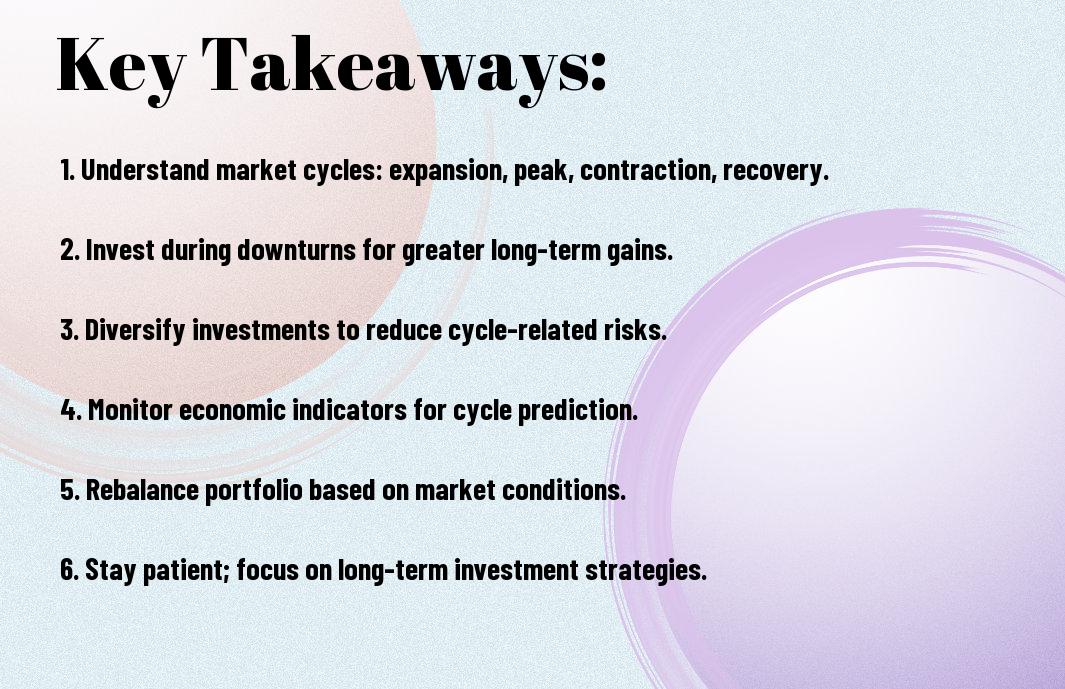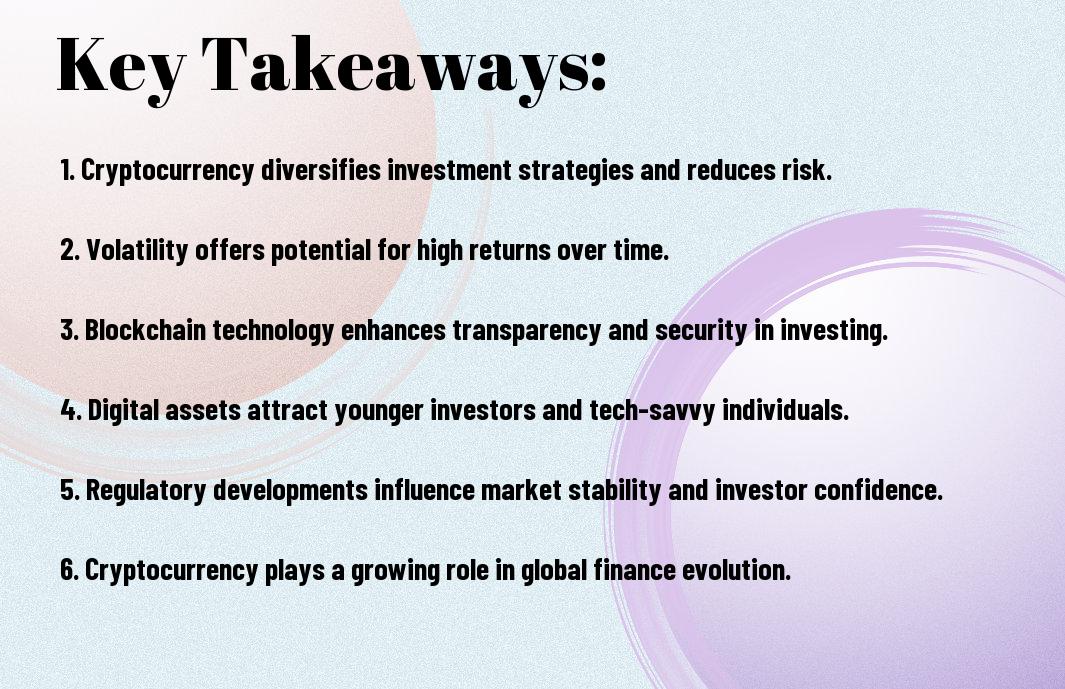Many investors overlook the importance of market cycles, which can significantly influence your investment outcomes. By understanding these cycles and recognizing the patterns of economic booms and downturns, you can make more informed decisions on when to buy or sell assets. This post will guide you through the key concepts of market cycles, helping you optimize your investment strategy and ultimately enhance your returns. Get ready to transform your approach and capitalize on the natural fluctuations of the market.
Key Takeaways:
- Understanding Market Cycles: Familiarizing yourself with the various phases of market cycles—expansion, peak, contraction, and trough—can enhance investment timing and strategies.
- Asset Allocation: Adjusting your portfolio allocation based on market conditions can help optimize returns; consider high-risk assets during expansions and safer investments during contractions.
- Emotional Discipline: Staying rational and avoiding emotional reactions during market fluctuations can significantly improve investment decisions and overall performance.


Understanding Market Cycles
For successful investing, it is necessary for you to understand market cycles, which are the natural fluctuations of market conditions that impact asset prices. By identifying these cycles, you can strategically time your investments for optimal returns. Explore more on Leveraging Market Cycles for Maximum Returns to enhance your investment strategy.
Phases of Market Cycles
Market cycles can be divided into several distinct phases, including accumulation, markup, distribution, and markdown. Understanding each phase helps you make informed decisions that align with the cycle’s dynamics.
Historical Perspectives
Cycles have historically followed patterns driven by economic, political, and social factors. You can benefit from analyzing past market cycles to identify trends and behaviors that might inform your current investment strategies.
Historical analysis shows that markets typically experience periods of growth followed by declines, often influenced by interest rates, consumer confidence, and global events. By studying these trends, you can predict potential market movements and adjust your investment approach accordingly, making your portfolio more resilient in varying conditions.
Identifying Market Cycles
While understanding market cycles is necessary for making informed investment decisions, recognizing the phases of economic expansion and contraction can significantly enhance your investment strategy. By familiarizing yourself with the characteristics of these cycles, you position yourself to enter and exit positions at the most opportune times, ultimately maximizing your returns and minimizing risk.
Tools and Indicators
With a wide array of tools and indicators available, you can better identify market cycles and their corresponding phases. Utilizing chart patterns, technical indicators, and sentiment analysis enables you to gain valuable insights into market trends, helping you make well-informed decisions about your investments.
Economic Indicators to Watch
Tools like GDP growth rates, unemployment data, and consumer spending are necessary for recognizing economic shifts that signal the start or end of market cycles. By tracking these indicators, you can detect patterns of growth or contraction, allowing you to align your investment strategies with the current economic landscape.
Another important aspect of monitoring economic indicators is paying attention to leading indicators such as stock market performance, new housing starts, and manufacturing activity. These indicators often signal future economic performance and can provide early warnings about shifts in market cycles. Staying informed about these data points will enable you to capitalize on opportunities and adjust your portfolio in alignment with changing economic conditions.
Strategies for Leveraging Market Cycles
Many investors overlook the importance of adapting their strategies based on market cycles. By recognizing patterns and aligning your investment approach accordingly, you can capitalize on opportunities that arise during different phases of the economy. This means honing in on not only when to enter or exit positions but also adjusting your overall investment strategies to match the current market environment.
Timing Your Investments
By aligning your investment timing with recognized market cycles, you can position yourself to buy low and sell high. This requires patience and observance of market trends, allowing you to take advantage of mispriced assets as they rise and fall in value. Crafting your strategy around these cycles can significantly enhance your potential returns.
Asset Allocation Adjustments
Strategies that involve adjusting your asset allocation in response to market cycles can lead to better performance. This involves analyzing your current portfolio and reallocating assets to reflect the prevailing economic environment. Shifting your investments among stocks, bonds, and other asset classes based on market phases allows you to optimize returns while managing risk more effectively.
Even small adjustments in your asset allocation can yield significant results over time. For instance, during market expansions, you might allocate a higher percentage of your portfolio to equities to capture growth, while in downturns, shifting towards safer assets like bonds helps protect your wealth. Regularly reviewing and fine-tuning your allocation strategy ensures alignment with current market conditions, allowing you to navigate cycles with greater precision.
Risk Management During Market Cycles
Not all market fluctuations are predictable, which is why robust risk management is crucial for maximizing your investment returns. You should focus on strategies that suit your risk tolerance, including finding the right amount of leverage for your portfolio. By knowing when to adjust your exposure, you can effectively shield your investments from adverse market conditions, ultimately improving your portfolio’s performance.
Hedging Techniques
Before exploring into market cycles, consider implementing hedging techniques that can mitigate risks. Utilizing options, futures, or other derivative products allows you to protect your assets, ensuring that you’re shielded from significant downturns while maintaining your portfolio’s potential for growth.
Diversification Strategies
Techniques such as diversification can bolster your portfolio against the unpredictable nature of market cycles. By spreading your investments across various asset classes, sectors, and geographies, you minimize the impact of poor performance in any single area, enhancing overall stability and potential returns.
Considering the importance of diversification, you might explore different asset types such as stocks, bonds, real estate, and even commodities. This approach not only reduces volatility but also allows your portfolio to benefit from various market opportunities. As market conditions change, different asset classes may perform differently, providing a buffer against losses in downturns. Aim for a balanced mix that aligns with your financial goals and risk tolerance to achieve a more resilient investment strategy.
Case Studies: Successful Investors
For effective market cycle strategies, you can draw insights from successful investors who have excelled in navigating investment environments.
- Warren Buffett: Achieved a 20% annual return by buying undervalued stocks during bearish markets.
- Ray Dalio: Utilized economic data to forecast market cycles, delivering a consistent return of over 8% annually.
- Carl Icahn: Targeted distressed companies during downturns, generating an average return of 10% above the market index.
- Peter Lynch: Exploited growth companies during recovering markets, achieving average annual returns of 29% in the 1980s.
Learning from Market Leaders
Around every corner of the investment landscape, you’ll find leaders who have utilized market cycles to their advantage. Their strategies often involve research, discipline, and risk management, enabling them to make informed decisions that result in impressive returns. By studying their approaches, you can discover valuable techniques to enhance your own investment strategies.
Common Mistakes to Avoid
From novice to seasoned investors, everyone can fall into traps that undermine their success. Some of these mistakes include not performing due diligence during various market cycles, failing to adjust your strategy based on changing economic indicators, and letting emotions dictate your investment decisions.
Common pitfalls often stem from a lack of preparation or reliance on market predictions instead of personal analysis. You may find yourself overreacting to temporary market fluctuations, leading to impulsive buying or selling decisions. Additionally, sticking to a rigid strategy without considering current market conditions can result in missed opportunities or significant losses. Guarding against these mistakes will enhance your ability to leverage market cycles effectively.
Future Outlook on Market Cycles
Your understanding of market cycles will be paramount as you navigate the ever-evolving landscape of investing. While the past can provide valuable insights, the future remains filled with uncertainties. Factors such as technological advancements, geopolitical shifts, and economic policies will shape the next wave of market movements. Staying ahead of these trends will empower you to adjust your strategies and enhance your investment returns.
Predicting Market Trends
Behind every market cycle lies a series of indicators that can help you anticipate future movements. While predicting exact market turns is challenging, a close analysis of historical data, economic fundamentals, and social sentiment can offer clues to emerging trends. By staying informed and vigilant, you position yourself to better recognize opportunities as they arise.
Adapting Strategies for Change
Market dynamics necessitate continuous adjustment of your investment strategies to stay relevant and effective.
This flexibility allows you to align your portfolio with shifting market conditions and make informed decisions, minimizing risks while maximizing growth potential. Utilizing tools such as stop-loss orders and diversification can cushion your assets against volatility. Additionally, embracing a learning mindset will enable you to refine your approaches based on new information and evolving market behaviors, ensuring you are well-prepared for whatever the future holds.
Conclusion
With this in mind, understanding market cycles empowers you to make informed investment decisions that can enhance your returns. By recognizing the stages of cycles—expansion, peak, contraction, and trough—you can strategically position your portfolio to exploit opportunities and mitigate risks. Tailoring your investment strategy according to these cycles, whether by diversifying or reallocating assets, enables you to optimize your financial growth and achieve your long-term financial goals.
FAQ
Q: What are market cycles and how do they impact investment strategies?
A: Market cycles refer to the fluctuations of asset prices over time, which typically include periods of expansion (bull markets) and contraction (bear markets). Understanding these cycles helps investors make informed decisions. By identifying the stage of the market cycle, investors can adjust their strategies—such as increasing equity exposure during bull markets or shifting to safer assets during bear markets—ultimately leading to better investment returns.
Q: How can I identify the phase of a market cycle?
A: Identifying the phase of a market cycle involves analyzing various economic indicators and market behavior. Key indicators include GDP growth, unemployment rates, interest rates, and consumer confidence levels. Additionally, observing market sentiment and price trends can provide insights. Tools like technical analysis charts and economic reports can assist in determining whether the market is in expansion, peak, contraction, or trough phases, thereby guiding investment decisions accordingly.
Q: What strategies can be adopted to benefit from different market cycles?
A: Depending on the market cycle, investors can adopt various strategies. In a bull market, strategies like buying growth stocks, leveraging options, or investing in cyclical sectors may yield high returns. Conversely, in a bear market, safeguarding investments through defensive stocks, bonds, or alternative assets can help preserve capital. Additionally, adopting a value investing approach by purchasing undervalued assets during market downturns can result in significant long-term gains when the market rebounds.



